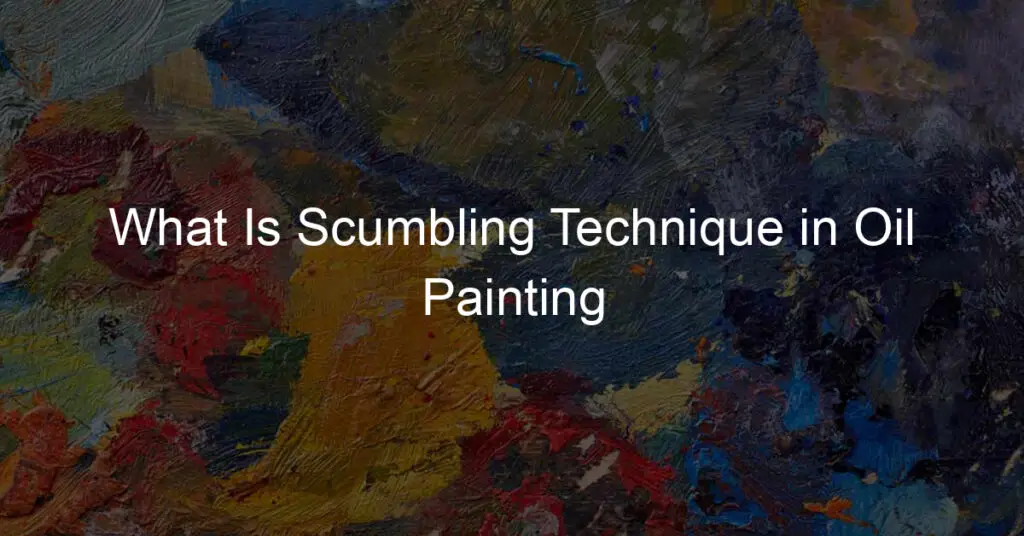Are you an oil painter curious about the scumbling technique? Are you looking for ways to add fine details and depth to your work without all the layers of paint and patience that come with other techniques? Scumbling could be just what you need! This versatile method has been used since classical times and is often combined with glazing to create very complex works.
In this blog post, we'll explore what scumbling is, how it's different from other painting techniques, and ultimately discuss why it's such a unique tool in any oil painter's arsenal.
What is scrubbing in oil painting?
Scrubbing in oil painting is a technique where the artist pushes thick and textured paint into the canvas with a tool or cloth. This entails scraping and pushing the paints against the canvas so that they blend. It is different from brushstroke techniques because it creates layers of texture rather than uniform coloring.
The result is a piece that has depth and richness, often resembling impasto paintings that feature bold and 3D brushstrokes. Scrubbing using an oil-based medium like petroleum jelly or oil paint adds an interesting experience as it can be both intense and pleasurable as you control each layer of paint, one at a time!
What are Scumbling art techniques?
Scumbling art techniques are used to create a beautiful and unique texture on the canvas with soft effects. It's a great way to add depth and dimension to your painting without completely changing the colors or shades of objects. This technique is achieved by applying thin layers of color over dry paint, which reveals hidden details and gives an amazing dimensional quality to finished pieces.
Scumbling is often used in portrait painting, but can be equally effective for landscapes or still life paintings. With the right amount of practice, it can add subtle details that take artwork from average to extraordinary.
How do you make a Scumble painting?
Scumbled painting is an amazing, textured effect that can be achieved with a variety of paints or pastels. To get started, you’ll want to select your base color and apply it in layers over the canvas. Once you’ve achieved the desired thickness for that layer, simply begin to lightly scumble colorless paint on top.
Sometimes adding texture, such as leaves or flowers, can give your final painting an additional depth and dimension that makes it come alive. Lastly, set your finished piece aside to dry completely before framing and showing off your beautiful masterpiece.
What would result if Scumbling is used in an artwork?
Scumbling is an exciting and unique painting technique that can add a whole new dimension to the artwork. It involves taking a thicker paint or another substance, such as beeswax, and layering it directly onto the canvas using a tool, such as a rubber shaper or palette knife.
The result is a visualization of texture, where light reflects differently off the ridges and irregular surfaces created by the overlapping impasto. This lends an artistic air of imperfection to any work – adding movement, perspective, and subtlety.
All these different effects will help to create a more detailed composition, especially when paired with more traditional elements like the proper blending of colors and brushstrokes. For anyone looking to add interest and depth to their paintings, scumbling should be considered!
How long does Scumble take to dry?
Applying a coat of Scumble is the perfect way to achieve an antique look for your home decor projects. But, how long does it take to dry? The answer depends on how thickly the product has been applied and the humidity levels of your surroundings.
Generally speaking, it should take around 12-24 hours for a light layer of Scumble to dry completely. For those wanting to speed up the process, you can consider using a hairdryer but always make sure you use the lowest heat setting and keep a consistent distance away from where the product is applied. If anything else, keep patience as your main ally – letting it cure naturally is usually best!
Conclusion: What Is Scumbling Technique in Oil Painting?
The scumbling technique is a great way to add dimension and life to your oil paintings. With its unique combination of back-and-forth, diagonal or crisscross strokes, scumbling can produce some truly spectacular-looking oil paintings.
Best of all, this method does not take a lot of time or skill to master. All that's left for you to do is get creative! Experiment with different directions and speeds of the brushstrokes until you find what looks best on your canvas. Who knows –


















